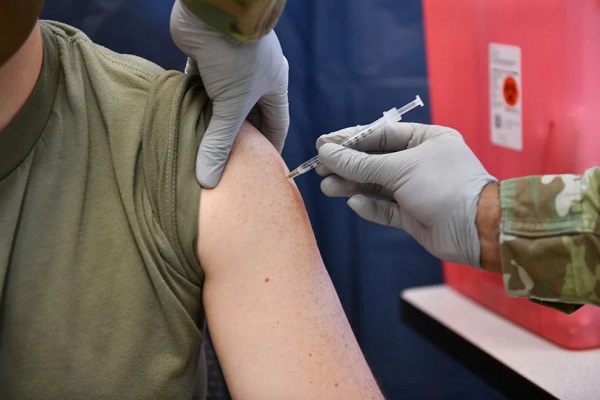Alberta
Province announces a new High School for Blackfalds and plans for a new Middle School in Red Deer

Minister LaGrange, Minister Panda and Minister Sawhney announce provincial school capital funding at Nose Creek School in Calgary.
From the Province of Alberta
Building schools for the future
Following through on its commitment to continue building new schools, the province has announced 25 new school projects.
The Budget 2019 capital plan supports 15 new schools, including brand new high schools in Calgary, Edmonton, Leduc, Blackfalds and Langdon. Six schools are slated for replacement and four will receive modernization or additions. Together, the 25 projects will receive $397 million.
“We made a promise to Albertans that our government will continue to build new schools, and we are doing exactly that. Through our significant investment in new schools, replacements, modernizations and infrastructure upkeep, our children will continue to learn in up-to-date and safe spaces. This will result in better success in our classrooms. The future is bright for Alberta students.”
“These 25 projects confirm our government’s commitment to continue to build schools across the province. Alberta Infrastructure will continue to deliver key infrastructure projects to build prosperity for Albertans.”
Budget 2019 also includes $1.4 billion over four years to continue work on previously announced school projects across Alberta, which includes $123 million for about 250 new modular classrooms to address the most urgent needs for additional space across the province. There are more than 60 projects underway in the province. Twenty-seven are expected to be open for the 2020-21 school year, and the remaining projects are in various stages of planning and construction.
The province will also provide $527 million to school divisions for plant operations and maintenance to support the day-to-day upkeep of school facilities. Additionally, $194 million will support the capital maintenance and renewal of existing school buildings through the Infrastructure Maintenance and Renewal Program.
“I am pleased that the government chose to make this announcement here in Calgary-North East. Students and families in my community will be relieved to hear that they will be getting the new high school we have needed for a long time. I’m proud that this critical funding was included in Budget 2019, as this was one of my first and most important motivations for why I wanted to represent Calgary-North East at the legislature.”
“On behalf of our students and the Calgary Board of Education, we would like to thank Minister LaGrange and Minister Panda for this important investment in school capital. We are pleased they chose to come to Calgary to make this provincial announcement and look forward to new CBE schools that will benefit students in north Calgary and in the growing community of Auburn Bay.”
The 25 capital projects are:
| Community | School Authority | Project Type/Name |
|---|---|---|
| *Beaumont | Conseil scolaire Centre Nord (Greater North Central Francophone Education Region) | new school (K-12) |
| *Blackfalds | Wolf Creek Public Schools | new high school (9-12) |
| Buffalo Head Prairie | Fort Vermilion School Division | Blue Hills Community School addition & modernization |
| Calgary – Auburn Bay | Calgary Board of Education | new elementary school (K-4) |
| Calgary – Auburn Bay | Calgary Board of Education | new middle school (5-9) |
| Calgary – north | Calgary Board of Education | new high school (10-12) |
| Carstairs | Chinook’s Edge School Division | Carstairs Elementary School addition |
| Cochrane | Calgary Catholic School District | new elementary/junior high school (K-9) |
| Condor & Leslieville | Wild Rose School Division | David Thompson solution modernization/replacement |
| *Edmonton – south east | Edmonton Public Schools | new high school (10-12) |
| Edmonton – Windermere-Keswick | Edmonton Public Schools | new elementary/junior high (K-9) |
| *Edmonton – Heritage Valley Town Centre | Edmonton Catholic Schools | new high school (10-12) |
| Edmonton – Windermere/Keswick | Edmonton Catholic Schools | new elementary/junior high (K-9) |
| *Fort Chipewyan | Northland School Division | Athabasca Delta School modernization/replacement |
| *Grande Prairie | Peace Wapiti School Division | Harry Balfour School replacement |
| *Langdon | Rocky View Schools | new junior/senior high school (7-12) |
| *Leduc | Black Gold School Division | new high school (10-12) |
| Legal | Conseil scolaire Centre Nord(Greater North Central Francophone Education Region) | new elementary/junior high school (K-9) |
| Morinville | Greater St. Albert Catholic Schools | Morinville Community High School CTS modernization |
| Morrin | Prairie Land School Division | Morrin School replacement |
| Peace River | Conseil Scolaire du Nord-Ouest(Northwest Francophone Education Region) | École des Quatre-Vents replacement |
| *Red Deer | Red Deer Catholic Regional Schools | new middle school (6-9) |
| Smoky Lake | Aspen View Public Schools | H.A. Kostash replacement |
| *St. Albert | St. Albert Public Schools | Bellerose Composite High School addition & modernization |
| Whitecourt | Living Waters Catholic Schools | new elementary school (K-3) |
*Design funding
Alberta
Alberta takes big step towards shorter wait times and higher quality health care

From the Fraser Institute
On Monday, the Smith government announced that beginning next year it will change the way it funds surgeries in Alberta. This is a big step towards unlocking the ability of Alberta’s health-care system to provide more, better and faster services for the same or possibly fewer dollars.
To understand the significance of this change, you must understand the consequences of the current (and outdated) approach.
Currently, the Alberta government pays a lump sum of money to hospitals each year. Consequently, hospitals perceive patients as a drain on their budgets. From the hospital’s perspective, there’s little financial incentive to serve more patients, operate more efficiently and provide superior quality services.
Consider what would happen if your local grocery store received a giant bag of money each year to feed people. The number of items would quickly decline to whatever was most convenient for the store to provide. (Have a favourite cereal? Too bad.) Store hours would become less convenient for customers, alongside a general decline in overall service. This type of grocery store, like an Alberta hospital, is actually financially better off (that is, it saves money) if you go elsewhere.
The Smith government plans to flip this entire system on its head, to the benefit of patients and taxpayers. Instead of handing out bags of money each year to providers, the new system—known as “activity-based funding”—will pay health-care providers for each patient they treat, based on the patient’s particular condition and important factors that may add complexity or cost to their care.
This turns patients from a drain on budgets into a source of additional revenue. The result, as has been demonstrated in other universal health-care systems worldwide, is more services delivered using existing health-care infrastructure, lower wait times, improved quality of care, improved access to medical technologies, and less waste.
In other words, Albertans will receive far better value from their health-care system, which is currently among the most expensive in the world. And relief can’t come soon enough—for example, last year in Alberta the median wait time for orthopedic surgeries including hip and knee replacements was 66.8 weeks.
The naysayers argue this approach will undermine the province’s universal system and hurt patients. But by allowing a spectrum of providers to compete for the delivery of quality care, Alberta will follow the lead of other more successful universal health-care systems in countries such as Australia, Germany, the Netherlands and Switzerland and create greater accountability for hospitals and other health-care providers. Taxpayers will get a much better picture of what they’re paying for and how much they pay.
Again, Alberta is not exploring an untested policy. Almost every other developed country with universal health care uses some form of “activity-based funding” for hospital and surgical care. And remember, we already spend more on health care than our counterparts in nearly all of these countries yet endure longer wait times and poorer access to services generally, in part because of how we pay for surgical care.
While the devil is always in the details, and while it’s still possible for the Alberta government to get this wrong, Monday’s announcement is a big step in the right direction. A funding model that puts patients first will get Albertans more of the high-quality health care they already pay for in a timelier fashion. And provide to other provinces an example of bold health-care reform.
Alberta
Alberta’s embrace of activity-based funding is great news for patients

 From the Montreal Economic Institute
From the Montreal Economic Institute
Alberta’s move to fund acute care services through activity-based funding follows best practices internationally, points out an MEI researcher following an announcement made by Premier Danielle Smith earlier today.
“For too long, the way hospitals were funded in Alberta incentivized treating fewer patients, contributing to our long wait times,” explains Krystle Wittevrongel, director of research at the MEI. “International experience has shown that, with the proper funding models in place, health systems become more efficient to the benefit of patients.”
Currently, Alberta’s hospitals are financed under a system called “global budgeting.” This involves allocating a pre-set amount of funding to pay for a specific number of services based on previous years’ budgets.
Under the government’s newly proposed funding system, hospitals receive a fixed payment for each treatment delivered.
An Economic Note published by the MEI last year showed that Quebec’s gradual adoption of activity-based funding led to higher productivity and lower costs in the province’s health system.
Notably, the province observed that the per-procedure cost of MRIs fell by four per cent as the number of procedures performed increased by 22 per cent.
In the radiology and oncology sector, it observed productivity increases of 26 per cent while procedure costs decreased by seven per cent.
“Being able to perform more surgeries, at lower costs, and within shorter timelines is exactly what Alberta’s patients need, and Premier Smith understands that,” continued Mrs. Wittevrongel. “Today’s announcement is a good first step, and we look forward to seeing a successful roll-out once appropriate funding levels per procedure are set.”
The governments expects to roll-out this new funding model for select procedures starting in 2026.
* * *
The MEI is an independent public policy think tank with offices in Montreal, Ottawa, and Calgary. Through its publications, media appearances, and advisory services to policymakers, the MEI stimulates public policy debate and reforms based on sound economics and entrepreneurship.
-

 Also Interesting1 day ago
Also Interesting1 day agoMortgage Mayhem: How Rising Interest Rates Are Squeezing Alberta Homeowners
-

 2025 Federal Election1 day ago
2025 Federal Election1 day agoConservative Party urges investigation into Carney plan to spend $1 billion on heat pumps
-

 Alberta2 days ago
Alberta2 days agoAlberta’s embrace of activity-based funding is great news for patients
-

 2025 Federal Election1 day ago
2025 Federal Election1 day agoCommunist China helped boost Mark Carney’s image on social media, election watchdog reports
-

 COVID-192 days ago
COVID-192 days agoMassive new study links COVID jabs to higher risk of myocarditis, stroke, artery disease
-

 2025 Federal Election1 day ago
2025 Federal Election1 day agoFifty Shades of Mark Carney
-

 Also Interesting2 days ago
Also Interesting2 days agoExploring Wildrobin Technological Advancements in Live Dealer Games
-

 2025 Federal Election1 day ago
2025 Federal Election1 day agoCorporate Media Isn’t Reporting on Foreign Interference—It’s Covering for It





